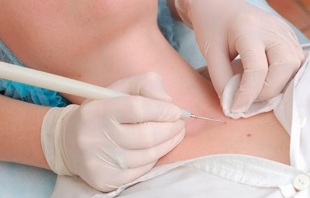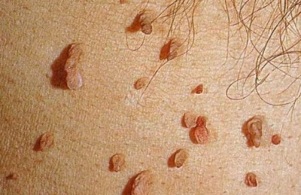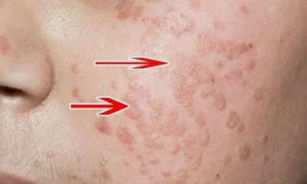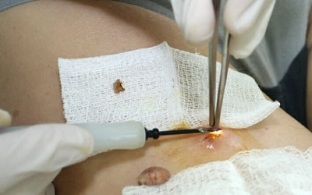
Human papillomavirus (HPV, HPV- human papillomavirus) or papillomavirus is a group of infections involving more than 100 types of viruses, 80 of which are pathogenic to humans. According to data from the World Health Organization, 70% of the world's population are carriers of HPV. In most cases, infection occurs after the onset of sexual activity and can be asymptomatic for a long time.
due to HPV infection
Papillomavirus infection in women can be: various types of warts, flat and genital warts, cervical dysplasia. However, the most dangerous manifestation of pathology is the development of cervical cancer. Some types of human papillomavirus (HPV 16, There is also data linking the development of cancer of the anus, external genital organs, vagina with infections of 18, 45, 56 types).
methods of transmission:
- sexual contact.The main route of transmission of human papillomavirus infection. Using a condom during exposure significantly reduces the risk of infection with human papillomavirus, however, it does not provide a reliable guarantee that infection will not occur. , Because viral particles are very small in size.
- Contact-home path.The cause of infection is the use of combined intimate hygiene products: towels, soaps, use of public toilets, bathing.
- natural delivery.HPV can be transmitted to children who become infected when an infected woman passes through the birth canal.
The source of this infection is the cells of the patient's skin and mucous membranes. In this case, a person himself does not know that he has become a carrier of the virus, as warts and papillomas can be microscopic in shape and can be visualized. Can remain invisible during.
Predetermining factors contributing to the development of viral infection:
- onset of sexual activity at an early age;
- sex without using a condom;
- frequent abortions;
- presence of infectious diseases of the genital organs;
- long term use of oral contraceptive methods;
- decrease in the body's immune response;
- Non-adherence to personal hygiene rules;
- if the sexual partner has HPV;
- constantly exposed to stressful situations;
- Bad habits.
Through microtrauma of pores, cracks, skin and mucous membranes, the virus enters the basal layer of the epithelium, which ensures normal growth and renewal of the skin and mucous membranes. DNA of basal layer cells (deoxyribonucleicAcid) provides information about the healthy structure of cells. A viral particle, which is being incorporated into DNA, replaces this information, resulting in the formation of affected cells, which in the process of development and division of the diseaseCauses symptoms.
symptoms of human papillomavirus infection in women

One of the possible manifestations of human papillomavirus infection is the presence of genital warts and papillas. They are typical structures that include a cauliflower, a bunch of grapes or a rooster comb, pinkish-red or flesh-colored. Depending on the type and type of virus, they can infect a person's skin and mucous membranes.
Genital warts can form around or near the anus, especially if there is anal intercourse.
Papilloma can occur on the skin, on the toes, toes, hands, around the eyes, armpits and scalp. They also sometimes form on the soles of the feet and cause a specific symptom while walking.
This type of disease rarely turns into a malignant tumor and cancer, however, to prevent the development of the disease, the structures are surgically removed.
HPV infection results
Human papillomavirus in women can lead to significant development of genital warts, papillomas, flat warts, which will cause discomfort, feelings of pain, and when they are injured, bleeding with varying severity. .
HPVs of the eighteenth and sixteenth types are the most dangerous, as they lead to the development of cancer. Cervical cancer, which is strongly associated with infection with the human papillomavirus, ranks second among various fatal diseases in women. The death rate reaches fifty percent.
flat warts

The disease is characterized by the formation of flat plaques that practically do not rise above the level of the skin.
Most often, the vaginal and cervical mucous membranes are affected.
The cosmetic defect with them is much smaller than that of genital warts.
This type of pathology increases the risk of cancer degeneration.
dysplasia of the cervical mucous membrane
Pathology is a change in the normal structure of cells in the mucous membrane of the cervix, called atypia. This condition is considered early in female disease and requires observation and intensive treatment.
In most cases the disease is asymptomatic and is detected during a routine examination by a gynecologist. Dysplasia of several degrees of severity is distinguished: mild, moderate, severe. The choice of treatment depends on the severity. Does.
Cervical Cancer
This is the most dangerous manifestation of the disease. Cervical cancer ranks second among tumor morbidity in women and is associated with infection with HPV types 16, 18.
The disease may progress without clinical signs or manifest itself with symptomatic symptoms: weakness, increased fatigue, weight loss, presence of vaginal bleeding outside the menstrual cycle.
Disease Treatment Methods
If there are signs of HPV infection, given the risk of outcome, do not self-medicate.
In order to select the optimal strategy of treatment, it is necessary to consult a gynecologist, who, after a thorough examination and performing the necessary tests, will prescribe adequate therapy.
So far, no drugs have been made that cure HPV forever. The main goal of the treatment is to reduce the concentration of the virus in the body to prevent further progression of the disease.
Main Areas of Medicine:
- Treatment of manifestations (warts, papilloma, dysplasia);
- antiviral therapy;
- use of funds intended to increase immunity.
In the presence of papilloma, genital warts, warts, dysplasia, even in a small size, it is recommended to remove them, as the presence of neoplasm increases the concentration of viral particles in a woman's body. , Which contributes to the progression of pathology.
Surgical treatment
Methods to remove genital warts, papillomas, warts and dysplasia are as follows:
- surgical;
- cryotherapy;
- diothermocoagulation;
- laser coagulation;
- radio wave therapy;
- Chemical attack.

The surgical method involved removing the augmentation with a scalpel is the cheapest method of treatment, however, after this, an obvious cosmetic defect remains and the duration of treatment is greatly prolonged. There is also a risk of infection. Therefore, this type of intervention is used in extreme cases.
During cryotherapy, liquid nitrogen is applied to the affected area, which freezes pathological formation. After a few days, the papilloma or condyloma disappears and a small lesion is formed beneath it, which 10Cures in 14 days.
Diathermocoagulation is the application of high temperatures to areas of the affected skin. This procedure is quite painful and therefore requires anesthesia. The disadvantage of this method is the formation of rough scars in place of pathological structures.
During laser coagulation, the effect of the laser beam on the affected area dries up the neoplasm. A dry crust is formed in place of them, which disappears after a short time leaving the scar. Such treatment is the most gentle. Is, but its high cost is considered a disadvantage.
Radiowave therapy exposes the area affected by radio frequency waves. When using this type of treatment, there are no bleeding risks, no obvious scars are formed, but the disadvantage is high cost.
The chemical method is used when a small formation occurs. A special drug is applied to the affected area. After several applications, a crust is formed on the treated area, which disappears after a few days. is.
drug use
Drug therapy for human papillomavirus infection involves the use of the following groups of drugs:
- antiviral drugs;
- immunostimulants.
To reduce the concentration of the virus in a woman's body and prevent its further reproduction, a long course of antiviral therapy is prescribed. Medications are used in the form of tablets and suppositories, dose of treatment courseAnd the duration should only be determined by the attending physician.
Immunostimulants are determined after analyzing and detecting a low level of immunity to increase the body's defenses, accelerate the processes of the presence of immune cells, and stimulate the production of antibodies to fight the virus.
treatment of HPV infection in pregnant women
The presence of human papillomavirus infection in a woman's body does not affect the reproductive system and is not a contraindication to pregnancy. If there is an overgrowth of HPV during pregnancy, therapy for this condition during this periodNot done, treatment is prescribed after delivery.
However, a woman should be monitored by a doctor for the entire duration of her pregnancy. With the development of severe discomfort, gentle methods of therapy are prescribed. In extreme cases, when vaginal delivery due to the progression of HPVIf there are contraindications, a caesarean section is performed.
getting rid of HPV with folk remedies
At home, you can use such folk remedies as herbal decoction and infusions - for the treatment of papillomatosis, ointments - to get rid of the resulting warts, papillomas and warts.
Methods of preparing decoction and infection for the treatment of human papillomavirus infection:
- Horsetails, nettle herbs, rose hips, dandelion roots, banana leaves are mixed in equal amounts. At 3 cents. L. Consequently add 800 ml of water to the mixture, for 10 minutes on low heat. Boil, then leave the infusion for 3 hours. Apply 3 glasses a day for 30 minutes before meals.
- oregano herb, yarrow, immortal, St. John's wort, birch buds, nettles, calendula, coltsfoot, burnt roots, chamomile flowers, string, banana leaves, celandine, linden flowers, caraway seeds, similar to sageAdd 2 tablespoons to a thermos. L. The resulting mixture, add 500 ml of boiling water, leave to burn overnight. Take 0. 5 cups 4 times a day.
- valerian root, lemon balm herbs, parsley, marigold flowers, hop cones, motherwort are mixed in the same amount. Pour 1 tbsp in a thermos. l. As a result, add 0. 5 liters of boiling water and 3Leave the infusion for -5 hours. Apply 250 ml 2 times a day.
for the treatment of local manifestations:
- Clandine juice. The juice is made from fresh leaves or purchased from a pharmacy. Before applying the product, the skin of the affected area must be charred, and healthy areas near the affected area should be treated with aShould be treated with thick cream. Cholineine should be applied carefully on the affected skin. The procedure should be repeated every two days for a week until the pathological formation disappears.
- Garlic. The vegetable should be grated finely and mixed with the skin cream until it has a viscous consistency. Apply the resulting mixture of the formations 2-3 hours every day for a month. After the procedure, wash the skin with soapy water.
- Young walnuts. They should be crushed with a meat grinder, pouring the resulting mixture into a 0. 5-liter glass jar so that 2/3 is filled, pour the rest of the container with kerosene. 20 days. Leave the infusion, then strain through cheesecloth. Treat the affected skin 2 times a day.
After therapy and after getting rid of external manifestations of HPV, a woman is required to visit a gynecologist every six months to monitor and prevent disease progression.














































































